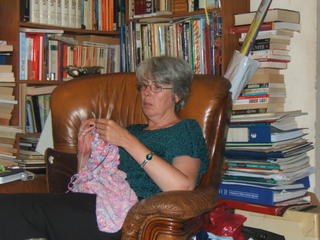How to estimate Yarn requirements
(This goes with the previous posting about the simple jacket design - again it is my copyright, so ask first - OK?)
Estimating Yarn - How-To (as requested by Heather & Nikki)
There are several ways you can do it:
1) Ask the lady in the shop where you buy the yarn - she may well be able to help/advise
or
2) If you can find a pattern for something similar in the yarn you've got, use the yarn requirements quoted in that pattern as a starting point. Say you can find a jumper pattern in your size, but you want a jacket. It's probably a good idea to add on an extra ball or 2 for edgings, collar, pockets etc.
If you can only find a ball of yarn similar in weight to your yarn (ie knits at the same tension), check out the yarn length for each ball of that (which may be quite different from the yarn which you actually have). See if you can find a pattern similar to what you want for that yarn, and look at the requirements for that yarn. What is the total yardage needed? - multiply the number of balls in the yarn requirement in the pattern by the yardage for one ball - then work out how many balls that would be in your yarn
or
3) European yarns usually carry a useful piece of info on the ball band. Look for the little picture of a jumper, it's normally for the average size female which I think in European terms will be quoted as 38-40, there will be an average yarn requirement for that garment (which should be a simple stocking stitch jumper with full length sleeves) given in grams. Convert to balls by dividing the number of grams needed by grams in the ball, eg. if it says 400 - 450 gms, and the ball contains 50 grams, then that's 400/50 = 8 balls or 450/50 = 9 balls. Almost always a good idea to add on an extra ball or 2 in case.
or
4) Divide the wool you have in half - using one of the halves, knit the back and one sleeve. If you haven't run out of your chosen half, then you probably have enough to complete.
or
5) A reasonably simple way to calculate yardage. Check your ball band - most balls of yarn now tell you the yardage in each ball. For this exercise only, the average chunky yarn has 50 yards to a 50 gram ball (the real yarn may be quite different).
Now look at my pattern for the simple jacket. A row of stocking stitch takes approximately a length of yarn 3 times the width of the piece you're knitting, so each row in the back 20 inches wide will take about 60 inches of yarn. Multiply that by the number of rows you need to get the length 24 inches (so that's 60 inches of yarn x 24 inches length of knitting x 5 rows per inch) which gives you 7200 inches or 200 yards. The fronts will take about the same amount again, so another 200 yards. Treat the sleeves as though they're ordinary rectangles, rather than tapered (but use the width at the top of the sleeve, not the bottom!) - that's 18 inches x 3 for the length of each row, ie 54 inches, then times 18 inches for sleeve length x 5 rows to the inch, and don't forget there are 2 sleeves(!), you get 9720 inches, or 270 yards. You also need to do the same for the front bands - 24 inches wide, so each row uses 72 inches, you have 8 rows for each band, so that's 72 x 16 = 1152 inches or 32 yards, and the collar about 16 inches wide (uses 48 inches a row, and there are about 22 rows, that's 48 x 22 = 1056 inches, or 29.33 yards. Total yardage needed is about 732 yards. Add on 10% to allow for errors, call it 800 yards. That's 16 balls of yarn.
or
6) The really anal method! (guess which one I'd use!) - Using one ball of your yarn and your larger size needles, cast on 100 stitches, and keep knitting in stocking stitch (or whatever stitch pattern you're going to use for the main part of your garment) till you run out, making a note of the number of completed rows. For example, say you complete 20.5 rows - ignore the half row, this will form part of the yarn allowed for sewing up (and safety margin)- so with one ball of yarn you can knit 20r x 100s = 2000 stitches. Looking at the pattern for my jacket, an average size as given, will eventually contain the following number of stitches:
Back - cast on row 1r x 60s = 60s
Back - garter band 8r x 60s = 480s
Back - stocking stitch 116r x 60s = 6960s
Cast off row 1r x 60s = 60s
Total for Back = 7560 stitches
2 Fronts - cast on row 2 x 1r x 27s = 54s
2 Fronts - garter band 2 x 8r x 27s = 432s
2 Fronts - stocking stitch 2 x 116r x 27s = 6264s
2 Fronts - cast oof row 2 x 1r x 27s = 54s
Total for 2 fronts = 6804 stitches
Sleeves - cast on row 2 x 1r x 30s = 60s
Sleeves - garter band 2 x 8r x 30s = 480s
rows before 1st increase 2 x 6r x 30s = 360s
rows before 2nd increase 2 x 6r x 32s = 384s
rows before 3rd increase 2 x 6r x 34s = 408s
rows before 4th increase 2 x 6r x 36s = 432s
rows before 5th increase 2 x 6r x 38s = 456s
rows before 6th increase 2 x 6r x 40s = 480s
rows before 7th increase 2 x 6r x 42s = 504s
rows before 8th increase 2 x 6r x 44s = 528s
rows before 9th increase 2 x 6r x 46s = 552s
rows before 10th increase 2 x 6r x 48s = 576s
rows before 11th increase 2 x 6r x 50s = 600s
rows before 12th increase 2 x 6r x 52s = 624s
finally for each sleeve, you have to knit a further 2.5 inches (or so) - that's 2.5 x 5 rows= 12.5 rows, call it 14 if you want to end with a purl row (makes casting off easier!)
after final increase 2 x 14r x 54s = 1512s
cast off row 2 x 1r x 54s = 108s
Total for 2 sleeves = 8064 stitches
Front bands - pick up row 2 x 1r x 90s = 180s
Garter stitch rows 2 x 8r x 90s = 1440s
Cast off row 2 x 1r x 90s = 180s
Total front bands = 1800 stitches
Neck edging - pick up row 1r x 50s = 50s
edging 6r x 50s = 300s
Collar 16r x 50s = 800s
Cast off row 1r x 50s = 50s
total for neck edging and collar = 1200 stitches
Grand total for jacket = 25428 stitches
Divide your grand total by the number of stitches you got for one ball, 25428/2000 = 12.714 balls. Obviously you have to round this up to the nearest number of whole balls, so that's 13 balls of yarn, and to be on the safe side I'd allow 10% extra, call it 15 balls in total.
Other things
Remember that garter stitch and rib use much more yarn than stotcking stitch. It's worth knitting a few rows in these to see just how much more.
ALWAYS buy more than you think you'll need, or see if the shop has a set aside policy (ie they'll reserve some extra for you in case you run out), or if they'll give you a refund / credit note if you return the unused balls in good condition. Otherwise be prepared to use up the spare stuff as scarves, sell it on eBay, add to your stash, etc.
Finally - things to do if after all that stuff above you still haven't got enough, for example you're stash-busting, rather than buying new? - See if you can get some more of the same yarn (check the dye-lot), if you can get the colour but not the dye-lot, knit it in stripes alternating every 2 rows between different dye-lots. If you can't get the same yarn / colour, then think about stripes of other yarns, or contrast edgings, or slip stitch patterns, or fair-isle. Maybe only knit a waistcoat instead. Consider knitting your pieces from the top down - divide the yarn you have into lots, 1/3 for the back, 1/3 for the front and 1/6 for each sleeve. If you knit downwards, you can see how close you can get to the desired length, and then finish off in your contrast yarn. Useful books here are any of those wonderful Odham's books published in England between about 1930 and about 1960 - and especially the ones published between 1940 & 1945 - they have titles like 'Practical Knitting' - these are full of useful tips about making do / mending (no, I'm not old enough to remember it!), and are great for stash-busting ideas, as well as being a real social history of knitting ...
Hope all of this has been of some help for you - I found that it was quite useful for me to set it all down, because it really made me think about how you do this properly (not for nothing is this b**g called Odd Ball Knitting - shameless plug here!)

















3 Comments:
I'm so glad you posted this here - it is incredibly useful! A veritable gold mine of information.
FAbulous instructions! Definitely worth bookmarking :) Out of interest, what do you do with what's left of the 'safety' 10% when it wasn't all needed? (Apart from curly whirlies!) Oh, and yes... Stashing around my desk at work means that J, my partner, doesn't know how much yarn I have. It is usually the 'far too good value' bulk buys that make it to work. ;)
Alison
Wow, what a helpful post this is! You could submit this to somewhere like Knitty or Magknits you know, I'm sure it deserves a wider audience. As an inheriter of my partner's mother's stash I am always trying to estimate how much odd bits of yarn I have at my disposal, with varying success.
Post a Comment
<< Home